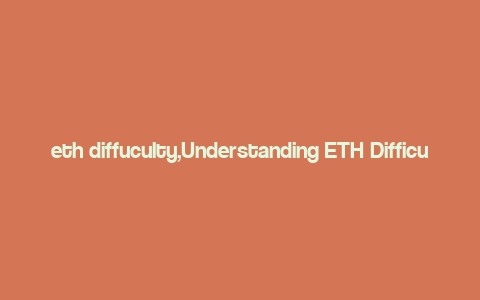Understanding ETH Difficulty: A Comprehensive Guide
When diving into the world of Ethereum, one term that often catches the attention of both beginners and veterans alike is “ETH Difficulty.” This metric plays a crucial role in the Ethereum network’s security and efficiency. In this article, we will explore what ETH Difficulty is, how it affects the network, and what it means for you as a participant in the Ethereum ecosystem.
What is ETH Difficulty?
ETH Difficulty, also known as Ethereum Difficulty, refers to the measure of how difficult it is to find a new block on the Ethereum network. It is a numerical value that represents the level of computational effort required to mine a new block. The higher the difficulty, the more computing power is needed to solve the cryptographic puzzle and mine a new block.
Difficulty is a crucial factor in maintaining the network’s security and ensuring that blocks are added to the blockchain at a consistent rate. It adjusts dynamically based on the network’s hash rate, which is the total amount of computational power dedicated to mining. If the hash rate increases, the difficulty will also increase, and vice versa.
How Does ETH Difficulty Affect the Network?
ETH Difficulty has several implications for the Ethereum network:
-
Security: A higher difficulty means that more computational power is required to mine a new block, making it more secure against attacks. It ensures that no single entity can dominate the network and manipulate the blockchain.
-
Consensus Rate: Difficulty affects the rate at which new blocks are added to the blockchain. A higher difficulty means that it takes longer to mine a new block, resulting in a slower consensus rate. Conversely, a lower difficulty leads to faster block creation and a higher consensus rate.
-
Block Reward: The difficulty level also influences the block reward for miners. As difficulty increases, the block reward decreases, as it becomes more challenging to mine a new block. This incentivizes miners to continue contributing to the network and ensures that the supply of new coins is controlled.
Understanding the ETH Difficulty Chart
ETH Difficulty charts provide a visual representation of the difficulty level over time. These charts are essential for understanding the network’s current state and predicting future trends. Here’s how to interpret them:
-
Time: The horizontal axis represents time, typically in days or weeks.
-
Difficulty: The vertical axis represents the difficulty level, measured in arbitrary units.

-
Trend: Look for patterns or trends in the chart. For example, a rising trend indicates increasing difficulty, while a falling trend suggests decreasing difficulty.
Factors Influencing ETH Difficulty
Several factors can influence ETH Difficulty:
-
Network Hash Rate: The total amount of computational power dedicated to mining directly impacts difficulty. An increase in hash rate leads to higher difficulty, while a decrease results in lower difficulty.
-
Network Size: The number of nodes participating in the network can also affect difficulty. A larger network typically leads to higher difficulty.
-
Block Reward: As mentioned earlier, the block reward influences difficulty. A decrease in block reward can lead to lower difficulty, as miners may find it less profitable to mine.
ETH Difficulty and Mining Pools
ETH Difficulty is particularly relevant for mining pools. Mining pools are groups of miners who combine their computational power to increase their chances of mining a new block. Here’s how difficulty affects mining pools:
-
Profitability: A higher difficulty means that it takes longer to mine a block, which can reduce profitability for mining pool participants.
-
Pool Size: Mining pools with a larger number of participants can better withstand the impact of increasing difficulty, as they have more resources to distribute the workload.
-
Pool Fees: Mining pools may adjust their fees based on difficulty levels to ensure profitability for their participants.
Conclusion
ETH Difficulty is a critical metric that affects the Ethereum network’s security, consensus rate, and profitability for miners. Understanding how difficulty works and its various implications can help you make informed decisions as a participant in the Ethereum ecosystem